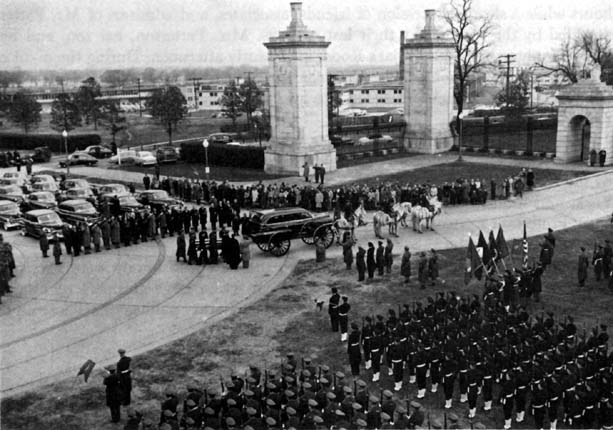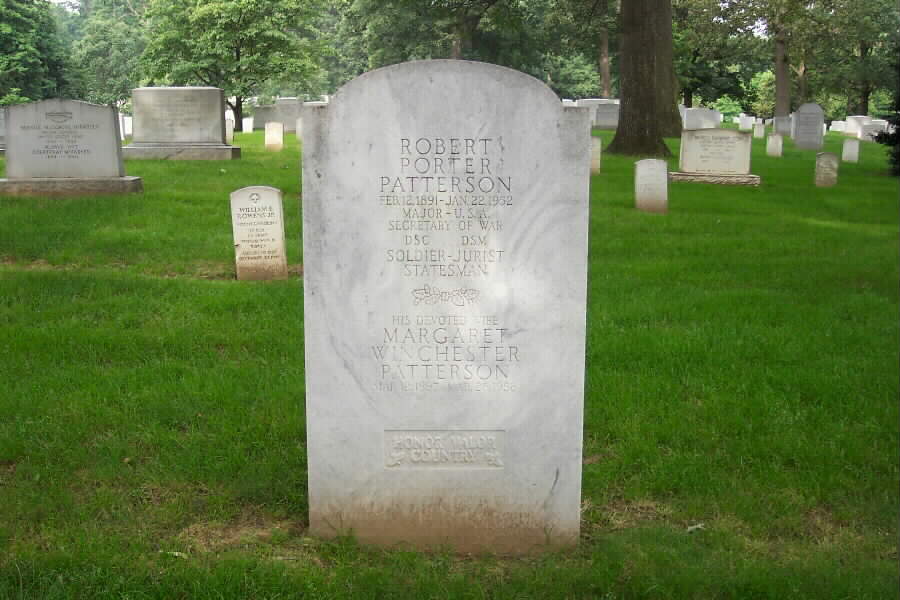PATTERSON, ROBERT P.
Captain, U.S. Army
306th Infantry Regiment, 77th Division, A.E.F.
Date of Action: August 14, 1918
General Orders No. No. 35, W.D., 1920
Citation
The Distinguished Service Cross is presented to Robert P. Patterson, Captain, U.S. Army, for extraordinary heroism in action near Bazoches, France, August 14, 1918.
Captain Patterson, accompanied by two noncommissioned officers, made a daring daylight reconnaissance into the enemy lines. He surprised an enemy outpost of superior numbers and personally destroyed the outpost.
Later he again had an encounter with another outpost, during which several of the enemy were killed or wounded and one member of his patrol wounded. The enemy advanced their outposts, and Captain Patterson covered the retreat of his patrol, during which he dropped into a depression and feigned being killed in order to escape capture. Here he lay until he was able to escape to his lines under cover of darkness.
Born in Glens Falls, New York, on February 12, 1891, he received his education from Union College and Harvard Law School, where he was President of the Law Review.
Patterson relocated to New York City where he practiced law from 1915 until he was appointed a US District Court Judge for the Southern District of New York in 1930. In 1939 he was appointed a judge on the US Circuit Court of Appeals.
At the outbreak of World War I, he volunteered for military service and went to France in April 1918, assigned to Company F, 306th Infantry Regiment. He served in various departments and in the Oise-Aisne and Meuse-Argonne offensives and was twice cited in general orders for gallant and meritorious service “in utter disregard of personal danger.”
At Bazoches, August 14, 1918, while making a daring daylight reconnaissance into enemy lines, he surprised and destroyed an enemy outpost and attacked another, killing and wounding several of the enemy. Later he was forced to retreat and in order to escape capture, dropped into a depression and feigned death, remaining there until nightfall when he escaped to his own lines. For heroism in this action, he was awarded the Distinguished Service Cross. He was wounded in action on August 16, 1918 and was awarded the Purple Heart. In March 1919 he was promoted to Major.
He returned to the United States in April 1919, was mustered out of the Army and resumed his law practice in New York.
In 1940 he was appointed Assistant Secretary of War. In just a few months be became the first U.S. Under Secretary of War. In this role, he supervised procurement and contracted for the delivery of over $100,000,000,000 worth of supplies and equipment, the largest amount of business ever done by a single organization in the history of the world and was also largely responsible for the desegregation of the Army. This is something he had aimed at all those years and was one of his proudest achievements. He then served as Secretary of War from 1945-47, and played an important role in the unification of the Armed Forces and the creation of the Department of Defense.
Secretary Patterson died, while on a private business trip, in a commercial airliner crash on January 22, 1952 and was buried in Section 30 of Arlington National Cemetery. His wife, Margaret T. Winchester Patterson, died on May 28, 1988 and was laid to rest with him.
Mobilizing America is the first book-length account of the critical role Robert Porter Patterson played as Under Secretary of War in forging the weapons of allied victory in World War II. Patterson, who resigned from the United States Court of Appeals in 1940 to join the War Department, faced the task of rapidly arming a threatened but completely unprepared nation in a world already at war. The task involved nothing less than the conversion of America’s vast and sprawling market-oriented economy into an effective war machine. As an “all-out” mobilizer, Patterson insisted that the nation put forth a maximum war effort. Eiler quotes him as saying, “We do not ask our boys in combat to do an adequate job; we ask them to do their best. We can do no less.”
After the war, President Truman offered Patterson a seat on the United States Supreme Court — an honor Patterson voluntary surrendered when the president decided he was indispensable at the War Department. As Secretary of War in 1945–47, Patterson presided over the demobilization of the great wartime forces and the dismantling of war industries. He frequently cautioned the nation against the precipitous dissipation of its armed strength in a disordered and still dangerous world.
Patterson died in an aircraft accident on January 22, 1952. He is remembered as a man of sterling integrity and as a supremely competent but completely selfless public servant.
Former Secretary of War Robert P. Patterson
Combined Services Full Honor Funeral
22-25 January 1952
On 22 January 1952 an American Airlines plane crashed at Elizabeth, New Jersey, as it approached a landing through fog and rain; six persons on the ground and all aboard the aircraft were killed. Among the plane’s passengers was Robert P. Patterson, former Secretary of War. He was sixty years old.
By current regulations the former Secretary of War would receive a Combined Services Full Honor Funeral. Major General Thomas W. Herren, commander of the Military District of Washington, was responsible for making the funeral arrangements in consultation with the Secretary’s widow, Margaret Winchester Patterson. Ceremonies were to take place in both New York City and Washington, D.C.; General Herren was in charge of the Washington ceremonies and the coordination of procedures for the entire funeral. Responsibility for conducting the ceremonies in New York City rested with the Commanding General, First U.S. Army, Lieuteannt General Willis D. Crittenberger.
By virtue of his Army service in World War I, during which he received the Distinguished Service Cross, Mr. Patterson was to be buried in Arlington National Cemetery. The gravesite selected was in Section 30, near the graves of William Howard Taft, James V. Forrestal, and Admiral Forrest P. Sherman.
Mr. Patterson’s body was brought to New York City from New Jersey shortly before noon on 24 January and placed in the Clark Room of the 7th Regiment Armory, where it was to lie until 2300. Massed behind the casket were four national colors, the personal flag of the Secretary of War, and the colors and standards of the parent units of two honor guards who took post at the casket. One of the guards was a member of the 306th Infantry, 77th Infantry Division (an Army Reserve unit), with which Mr. Patterson had served in France during World War I. The other was from the Army National Guard 107th Regiment. In 1916 Mr. Patterson had served with the 7th Regiment, later redesignated the 107th, on the Mexican border. All honor guards were furnished by the 107th and 306th Regiments and each two-man relief stood a half-hour watch. The honor guard members from the 306th were in battle dress, those from the 107th in dress gray uniforms specially designed for their regiment.
Beginning at noon on the 24th the armory was opened to the public for eleven hours while a steady procession of friends, associates, and admirers of Mr. Patterson filed by the bier to pay their last respects. Mrs. Patterson, her son, and her three daughters visited the Clark Room in the early afternoon. During the night of the 24th, Mr. Patterson’s body was taken by train to Washington and placed in the Washington National Cathedral to await the funeral service at 1500 on the 25th.
Retired Major General Luther D. Miller, canon of the cathedral and former Army Chief of Chaplains, conducted the midafternoon funeral service. He was assisted by the Reverend Lockett Ballard, rector of St. Phillip’s Church in Garrison, New York, and minister of the Patterson family, and by the Right Reverend Angus Dun, Protestant Episcopal bishop of Washington. Hymns were played before and after the service by the US Air Force Band.
Among those attending the service with the Patterson family were President Harry S. Truman and his family. Also present was a large group of dignitaries invited by the Patterson family to participate as honorary pallbearers. Those asked included:
Secretary of State Dean G. Acheson, Thomas B. McCabe, Major General Julius Ochs Adler General of the Army George C. Marshall, Montgomery B. Angell, Henry Morgenthau, Jr., Warren R. Austin, William L. Marbury,
Bernard M. Baruch, Admiral Ben Moreell, Chuncey Belknap, Basil O’Connor, General of the Army Omar N. Bradley, Floyd H. Odium, Dr. Ralph J. Bunche, Frederick H. Osborn, General Lucius D. Clay, Howard C. Petersen, Bradley Dewey, Samuel Pruyn, General J. Lawton Collins, Sam Rayburn, Dr. James B. Conant, John Duff Reed, Robert Cutler, Kenneth C. Royall, General James H. Doolittle, Elihu Root, Jr., Ferdinand Eberstadt, Coolidge Sherman, Peter Finucane, General Brehon B. Somervell, Edward S. Greenbaum, Herbert Bayard Swope, Former Judge Augustus N. Hand, Dr. Dwight Sawyer, Former Judge Learned Hand, Dr. Charles Sawyer, George L. Harrison, Major General Maxwell D. Taylor, Colonel Donald R. Hyde, John W. Waters, Major General John E. Hull,Thomas J. Watson, Judge John C. Knox, Vanderbilt Webb, Robert A. Lovett, Raymond Wilkins, M. J. Madigan, Boykin C. Wright, and W. G. Maguire.
CASKET IS TRANSFERRED TO THE CAISSON AT MEMORIAL GATE
Following the simple Episcopal service led by Canon Miller, Mr. Patterson’s casket was taken in procession from the cathedral and placed in a hearse. A motorized cortege escorted by two armored cars then proceeded to the Memorial Gate of Arlington National Cemetery.
A military escort meanwhile had formed on line on the green at the gate. The units included the US Army Band; Company A, 3d Infantry; the Navy Ceremonial Guard; the Marine Corps Ceremonial Company; and the 1100th Ceremonial Detachment from Bolling Air Force Base. On Memorial Drive directly in front of the military escort was the caisson, to which the casket would be transferred immediately after the cortege reached the Memorial Gate. Also on hand were a national color detail, a personal flag bearer, and a joint team of body bearers from three of the armed services: the Army, Navy, and Air Force.
When the cortege reached the Memorial Gate, the military escort presented arms and the Army Band played as the body bearers transferred the casket from the hearse to the horse-drawn caisson. Following the transfer, General Herren, as escort commander, led the way into the cemetery, entering on Roosevelt Drive. Behind him were the band, escort troop units, national color detail, Canon Miller, the caisson flanked by the body bearers, the personal flag bearer, the honorary pallbearers, the Patterson family, and other mourners, in that order. As the procession moved, the 3d Infantry battery, in position in the cemetery, fired a 19-gun salute, spacing the rounds so that the last one was fired as the procession arrived at the gravesite.
Canon Miller read the service at the grave. When he had finished, the battery from the 3d Infantry fired a second 19-gun salute. A rifle squad then delivered three volleys and an Army bugler sounded taps. The body bearers folded the flag that had draped Mr. Patterson’s casket and handed it to Canon Miller, who then gave it to the Patterson family minister, the Reverend Lockett Ballard, who presented the flag to Mrs. Patterson.
Light snow blew across the Buffalo Airport one afternoon last week as American Airlines Flight 6780, bound for Newark, taxied out for takeoff. The sky was overcast, ceiling 3,000 ft., visibility two miles.Out of Rochester, its first stop, the sleek two-engined Convair was eight minutes late. At Syracuse the snow was heavier and Pilot Thomas J. Reid landed a half hour behind schedule, late enough for Barbara Levy, Syracuse University sophomore. She had kept a taxi standing by while she finished a mid-term exam, had rushed to the Syracuse field to get a quick start on a winter vacation.
Behind Schedule. At 3:41, Captain Reid had his plane at 1,500 ft. over Linden, New Jersey, letting down to the northeast toward Newark Airport. He had been cleared for an instrument approach to Runway 6, had reported that he was receiving instructions from the control tower “loud and clear.” The snow had melted into light rain. The ceiling was down to 400 ft. and visibility was poor.
Now in his slowly descending approach to the landing runway, Captain Reid was flying along the shallow arc of a radio glide path. This was standard airline technique—to make bad-weather landings by I.L.S. (Instrument Landing System), with two crossed needles on the instrument panel to register any deviation from course.
On the airport in an old trailer, two men huddled over the radarscopes of the field’s G.C.A. (Ground Controlled Approach) equipment. They were in radio contact with Reid, were watching the glowing radar echo of his plane as it moved across their screens. G.C.A. operators are not responsible for a plane’s safety unless they are asked to take over. But almost always, wherever they are stationed, they monitor instrument landings.
When the Convair was four miles out, the G.C.A. told Captain Reid he was “300 ft. to left and coming back to course.” The next message advised Reid he was “right on course,” 100 ft. above the glide path with the tall (277 ft.) tower of the Elizabeth, NJ. courthouse one mile ahead of him. Within seconds, the Convair was pulling widely off her course. “Drifting 900 ft. to right of course . . .” flashed the urgent warning. At 3:44, the G.C.A. operator reported that Flight 6780 had moved completely off his radar screen.
A Singing Thing. Below, the rain and fog had driven Elizabeth’s residents indoors. Eugene Alvator, home for an early dinner with his wife and children, heard “a singing thing.” He walked to the door. The song ended in shocking crescendo; the crump of a crashing airplane, then the violent explosion of fuel tanks.
Just three-quarters of a mile from the spot where, last month, a flaming C46 crashed and killed 56 passengers, the Convair had nosed over into a fatal dive. After skimming a girls’ high school, one wing sliced into a three-story brick building and spun the plane into a two-family frame house. Blazing gas spewed over the neighborhood. Choking black smoke billowed up to thicken the fog. All 23 passengers, including former Secretary of War Robert P. Patterson, and crew members were killed. In the muck and charred ruins, Elizabeth (pop. 112,675) counted six of its own among the dead.
Sirens screamed through the afternoon, and the last flames were still flickering when furious citizens began their protest. The airport must go. All week long, investigators swarmed over the scene—from Washington, from the New Jersey legislature, from the CAA, the CAB. But Elizabethans were not half so interested in causes of the crash as they were in the exasperating probability that the airport would operate as usual, at least for ten months. Then, if construction is complete, a new instrument runway will bring traffic in over the marshlands to the east.
Captain Reid died at the age of 33. He was the captain of American Airlines Flight 6780, a Convair 240 N-94229, that crashed on January 22, 1952 at 3:43 pm in Elizabeth, New Jersey in route to Newark Airport. He had been with American Airlines and was checked out as a Convair Captain in April, 1951. At the time of the accident he had 7,062 hours of piloting, of which 2,483 had been in Convairs.Captain Reid’s daughter sent the following information. “According to the Newark Star Ledger of January 23, 1952, 32 people died, 23 on board the flight. Included in that number was the ex-Assistant Secretary of War under FDR, Joseph Patterson. My mother suffered a grief induced miscarriage at the time and Mrs. Patterson invited us to her West Point, New York horse farm. Being there was my earliest memory. I was 19 months old. I do not remember my father. At first there was “pilot error” as a cause, but years later I learned from my husband’s neighbor, who was in Newark’s tower that the investigators finally found that something did the opposite of what it should have. I have my father’s wedding ring; it’s bent from fighting the controls. My mother met someone she knew before she died who had seen the autopsy report. Both his wrists were broken.
Thomas Reid flew as a navigator for the Air Transport Command during WWII. He joined American after the war. We actually have a photo of him as part of the crew that flew Crown Prince Faisal of Saudi Arabia in the early 50’s or late 40’s. He was listed as a lost pilot as part of a dedication of Ernest Gann’s book, Fate is the Hunter.
2 February 1953:In Manhattan, Mrs. Margaret W. Patterson, widow of Robert P. Patterson, former Secretary of War who met his death in a plane crash in Elizabeth, N.J. a year ago, filed suit against American Airlines for $2,685,000, one of the largest individual damage claims ever filed against an airline.
M. W. Patterson, 91, Social Service Leader
30 march 1988 Margaret Winchester Patterson, a volunteer in social service organizations, died of heart failure Monday at her home in Manhattan. She was 91 years old.
Mrs. Patterson was a former director of the Army-Navy Relief Society. During World War II, she founded the Junior Army-Navy Guild Organization for servicemen’s families to do vounteer work in hospitals and canteens. She was a longtime reader to the blind at the Lighthouse and a tutor for the English-Speaking Union.
Mrs. Patterson was born in Baltimore. She was the widow of Robert P. Patterson, Secretary of War in the Truman Administration. She is survived by a son, Robert, of Manhattan; 3 daughters, Aileen Patterson Seldes and Susan Hand Patterson, both of Manhattan, and Virginia Montgomery of Bethesda, Md.; a brother, John G. Winchester of Jupiter Beach, Florida, and 10 grandchildren.
PATTERSON, ROBERT PORTER
- MAJOR 306 INF
- VETERAN SERVICE DATES: Unknown
- DATE OF BIRTH: 12/12/1891
- DATE OF DEATH: 01/20/1952
- DATE OF INTERMENT: 01/25/1952
- BURIED AT: SECTION 30 SITE 612
ARLINGTON NATIONAL CEMETERY
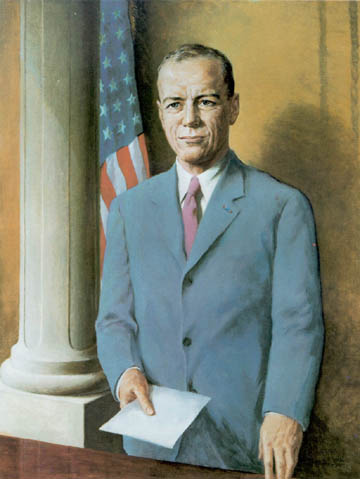
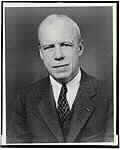
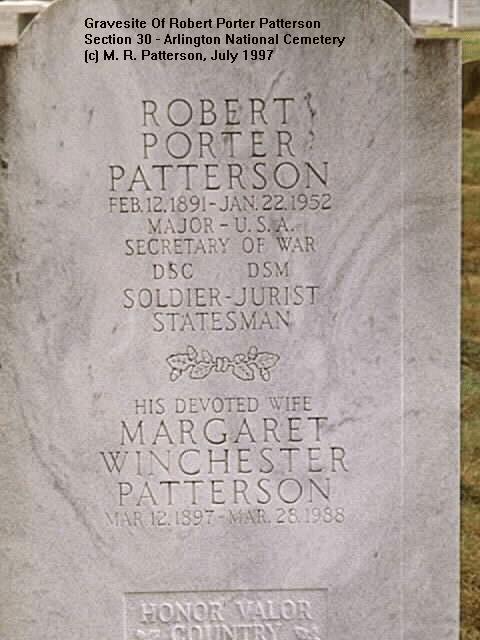
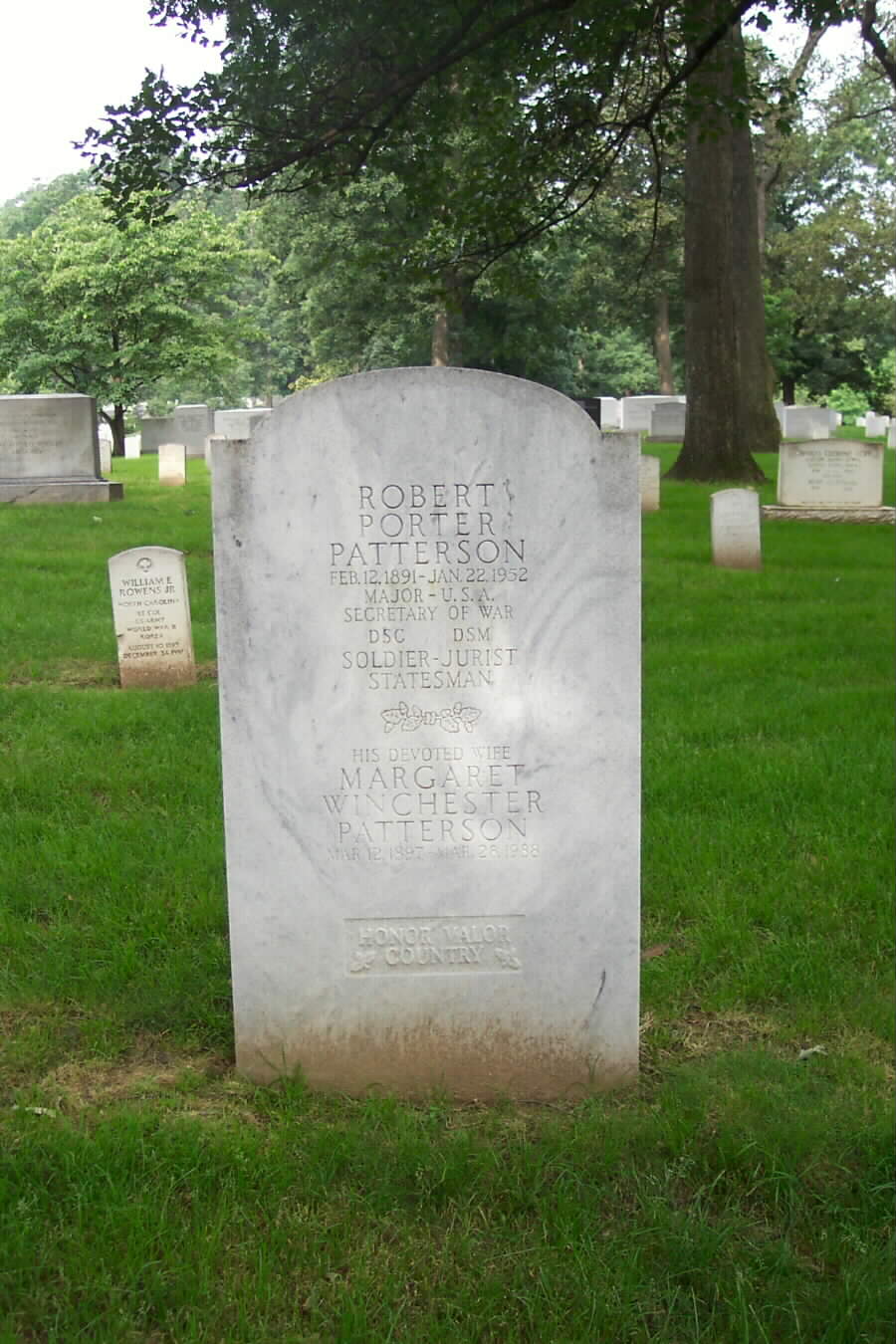
Michael Robert Patterson was born in Arlington and is the son of a former officer of the US Army. So it was no wonder that sooner or later his interests drew him to American history and especially to American military history. Many of his articles can be found on renowned portals like the New York Times, Washingtonpost or Wikipedia.
Reviewed by: Michael Howard

